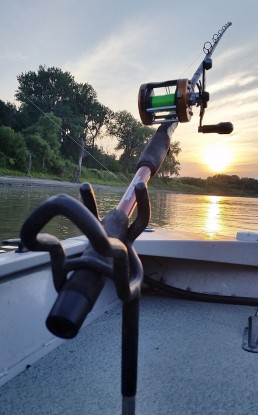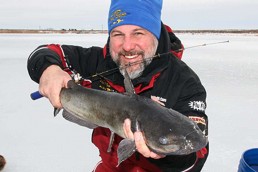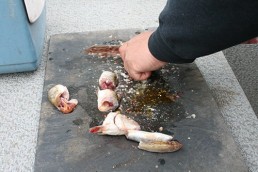Choosing the Right Catfish Rod
SHARE THIS POST
It seems in this day and age that we are always studying and trying to get better. We are always looking for the magic rod or lure that will give fish no choice but to jump into the boat or onto the shore.
I hate to break it to everyone, but there is no such gear. I view myself as an educator, as I like to learn and teach others about catfish patterns and how to better understand them so as to catch more and bigger fish.
Rods used to catfish have come a long way over just the past five or six years. Before that, catfish anglers were limited to finding offshore, bass, musky or trolling rods that would make do. Of course, there were some one-size-fits-all catfish rods on the market that worked well for some applications—and not so well for others. There were also a couple catfish-specific rods that were way ahead of their time, and are still the gold standard for what is being introduced today.
In our recent series, we have discussed the hooks and line used for catfishing. By understanding what each hook does, and what how the line plays into the equation, it is now time to determine what rod is the right rod for the job.
Why choose the right rod for catfish?
When you choose a catfish rod, there are a couple of things that must be considered to get the right one. I hate to break it to you, but there is no one-size-fits-all catfish rod. First, you have to determine what size of fish you plan to catch. Most people say “huge” fish at this point, and buy too much rod. What you need to do is determine whether you are going to catch channel cats that average three to five pounds, or 15 to 20 pounds. If you fish for flatheads or blues, you similarly have to decide what is the average fish you are going to catch. You have to determine this based on your local waters and how you fish if you are likely going to catch 20-pound blues or 80-pound blues.
The reason I bring this up is, catfish anglers always tend to think they are going to catch a 25-pound channel cat or a 100-pound blue cat, so they buy the heaviest rod they can purchase–just in case. This may be costing them fish because they bought too heavy a rod that, in my opinion, takes the enjoyment out of the catfish fight.
Choosing the right catfish rod
The proper way to look at this purchase is to determine the average catfish you are going to catch, and then plan accordingly.
I will use myself as an example. I fish the Red River between Minnesota and North Dakota where the average channel cat is nine or ten pounds. I also have a legitimate shot at a 20- to 25-pound channel cat with every hookup. I need a rod that is sensitive enough at the tip to determine when a fish as small as two pounds is playing with my bait, but possesses enough backbone to handle that 25-pounder that may be lurking in the depths.
Are you enjoying this post?
You can be among the first to get the latest info on where to go, what to use and how to use it!
A great example of this is a Rippin Lips Medium Supercat. It has a soft tip that allows a smaller catfish to turn a circle hook without feeling the rod ,but a heavy enough backbone that, with the right drag setup on the reel (we will discuss in a later article), you can fight the fish effectively.
If I am in situation of high current where I need to really beef up the sinker weights and fight the fish in heavy current, then I will upgrade to a medium heavy rod to gain a little extra backbone.
If you fish flathead or blue cat waters where the average fish is say 15 to 20 pounds, but you have a shot at a 40-, 50- or even 60-pounder, the medium heavy is the rod for you. But if you are on a body of water where an 80- or 100-plus-pound blue cat lives, you will want to move up again to maybe something even heavier, especially if you are fishing a pound or more of sinker and bait. (Most of us in the Midwest don’t have to worry about that.)
Pairing your rods to your hooks
In a previous article, I specifically mentioned the use of circle hooks. What rod you choose is also determined by what hook you plan to use. In the case of circle hooks, it is not the hook but the rod that makes it work properly, thereby making the rod choice even more important.
With a circle hook, you must have a rod that has a soft enough tip that the fish can pick up the bait, make a turn and start to run without feeling the pressure of the rod. While this is all happening, the circle hook is turning in the fish’s mouth, and when he hits the bottom of the rod bend he is hooked. If you are fishing with braided line and circle hooks, you will need to have a little bit softer tip on the rod to make up for the lack of stretch in the line.
When fishing with a traditional j-hook, you are setting the hook, so now you must consider the flex in the rod the other way. If the rod is soft for using circles, you may not get the setting power you need to catch the fish.
Not to worry; with the progression of the catfish industry, there are some rods on the market that can do both. I have explained the differences to the most dramatic of degrees. Rods such as the Rippin Lips rods mentioned earlier have a little less rod bend and a little quicker backbone. The tip has enough give to turn a circle hook, and a fast enough tip to the backbone that you can get enough set on a catfish. There are many others like this on the market today that were not around even five or six years ago.
Choosing the right rod for the job is a key element to fun and success that is still new to catfishing and widely misunderstood. There are some things you have to think about, as in how you fish and what you want to catch, to make an informed decision and choose the right rod for the job. After that, the only rod decision left is, do you want a casting or spinning rod? We will discuss that aspect in the next installment. MWO
Capt. Brad Durick is a nationally recognized catfish guide on the Red River of the North, seminar speaker and author of the books Cracking the Channel Catfish Code and Advanced Catfishing Made Easy. For more information, go to redrivercatfish.com.
MWO
SHARE THIS POST
Did you enjoy this post?
You can be among the first to get the latest info on where to go, what to use and how to use it!
MWO
We believe being outdoors is good. With more than 1,000 articles each year, MidWest Outdoors magazine is all about sharing outdoor experiences with you—where to go, what to use and how to use it… whether you’re close to home or on that trip of a lifetime.



